Use of this material in non-commercial technical presentations (e.g.
classes, research conference talks) is granted without need to obtain
permission. Please be considerate and indicate proper credit for the videos
you show.
You must obtain our permission to use this material in
any other way (e.g. in commercial presentations, web sites, or in any video
tape or film meant for broadcast or public display). Permission will require
your willingness to have us review and approve those parts of the final
script/site where our material is used. Once permission is obtained, we can
also provide access to the high quality DV format files. Please contact:
Prof. Gill A. Pratt
MIT AI Lab
NE43-006
545 Technology Square
Cambridge, MA 02139
gill@ai.mit.edu
(617) 253-2475 x101
The many students who worked on these robots were supervised by Prof. Gill
Pratt. The knee project, begun under Gill Pratt, is now under the direction of
Prof. Hugh Herr, who is now co-director of the Leg Lab.
Series-Elastic Actuator
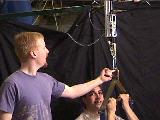

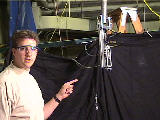
hea.mpg
The Leg Lab invented and developed several kinds of series-elastic
actuator, which use an instrumented spring in series with the load to
provide good characteristics for robots that execute natural tasks. Compared
to traditional robot actuators, series-elastic actuators have higher force
fidelity, shock tolerance, energy efficiency, and stability in contact.
Compared to other force controlled actuators, they are lower in cost,
smaller in size, and are more lightweight. The following video of a
hydraulic series-elastic actuator demonstrates first qualitatively
then quantitatively the dynamic range of the actuator (about 1 lb. out of
500 lb.), then demonstrates its force and motion bandwidth (50
Hz and 10 Hz, respectively).
Virtual Hexapod
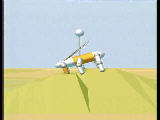
hexapod.mpg
The Virtual
Hexapod, created by Anne Torres, demonstrates the power of Virtual Model
Control, which is used to allow the hexapod's body to be controlled as if it
had force and torque thrusters, even though it actually has 6 legs with
non-linear kinematics including 18 controlled and 18 uncontrolled degrees of
freedom. In this video, the hexapod walks smoothly in various directions,
then balances an inverted pendulum (connected to the body via a universal
joint) while walking over rough terrain. Despite the complexity of the
emergent behavior, Virtual Model Control allows the controller to be
specified very simply. The controller is switched off at the end of the
video to demonstrate that the pendulum can, in fact, fall down.
Spring Turkey

turkey.mpg
Spring
Turkey was the leg lab's first walking robot, built by Peter Dilworth
and Jerry Pratt. It had 4 degrees of freedom (2 in each leg, at the hip and
knee) and point feet. It first demonstrated that series-elastic actuators
and virtual model control could be used to build a walking robot with
natural gait. These ideas were then used in the following robots.
Spring Flamingo
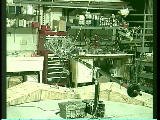

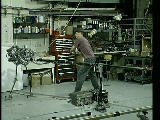
flamingo.mpg
Spring
Flamingo, built by Jerry Pratt and Mike Whittig, is a 2-D robot with 6
degrees of freedom (3 per leg). The first two scenes of this video shows
Spring Flamingo walking blindly over rough terrain. It has no foreknowledge
of the terrain, but can only feel it via proprioception. Next, in a
simulation done by Chee-Meng Chew, Spring Flamingo climbs up and down
stairs. While the steps were carefully synchronized to the phase and period
of Spring Flamingo's stride, the height of the steps was accommodated to by
proprioception. In the next clip, Jerry Pratt qualitatively tests the
robustness of Spring Flamingo to disturbances. More quantitative results can
be found in our papers. Finally, set to music, M2 is shown walking
about 1 meter/s. Its highest speed during other experiments was 1.25
m/s.
M2


m2sims.mpg
m2real.mpg
M2
is a 12 DOF autonomously powered and controlled humanoid robot being built
by Dan Paluska and several other leg lab students. There are two video files
for M2, one showing simulation, the other showing the real robot. In the
simulation video, a physically realistic simulation of M2 is first shown
capable of one leg and step to step balance. Next are simulations of bipedal
stopping, starting, and steady-state walking. Allen Parseghian and Jerry
Pratt programmed the simulations. In the real robot video, M2 is shown
balancing, wiggling ("Elvis dancing"), and stepping in place.
Finally, its first forward step (which was followed by a fall) is shown. We
are now working on getting M2 to walk robustly.
Troody
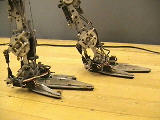
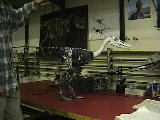
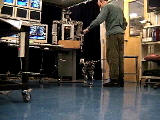
troody.mpg
Troody, the
creation of Peter Dilworth, is a 16 DOF autonomously powered and controlled
biped robot built to resemble a Troodon,
a small carnivorous dinosaur that lived in the Cretaceous. In this video,
Troody is shown standing up and walking across a desk (the cables provide
power, start/stop control, and safety in case of a fall). Next Troody is
shown taking a sharp left turn. Finally, Troody is shown taking a long
battery-powered walk from our basement laboratory to visit Cog on the 9th
floor (via the elevator). It only fell 4 times along the way.
Intelligent Prosthetic Knee
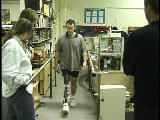
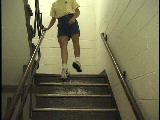
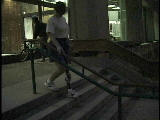
knee.mpg
The LegLab Intelligent Prosthetic Knee, built by Hugh Herr, Ari
Wilkenfeld, Theresa Iozzolino, Mike Whittig, and Olaf Bleck, allows
above-knee amputees to walk and climb stairs with a more natural,
automatically adaptive, gait. It does not require any manual tuning by a
prosthetist. This video of an early prototype of the knee first shows a test
subject changing walking speed, with the knee adapting its swing time
accordingly. Next, another test subject demonstrates how she usually gets up
and down stairs. Note that her "dumb" prosthetic leg remains
either locked or collapses. In the final clip, this same subject is shown
testing an early prototype of the knee going up and down stairs outside our
laboratory under the supervision of a prosthetist. Because of the knee's
intelligence, she can, for the first time, go up and down "stair over
stair", i.e. like an able-bodied person. Her resulting enthusiasm is
infectious, and is tremendously motivating for all of us.
Corn Dog (a.k.a. M4/2)
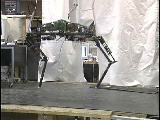
corndog.mpg
Corndog is a 2-D half-quadruped, built by Ben Krupp, consisting of a
single front and back leg, and a spine connecting the two. This video shows
corn dog pronking. Besides demonstrating control of height and pitch, this
video demonstrates the ability of Corn-Dog's electric series-elastic
actuators to efficiently and robustly absorb the shock energy of each
footfall, without any additional elasticity in the leg mechanism.
Blob
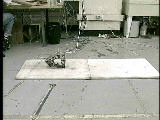

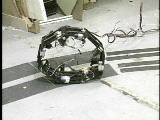
blob.mpg
The Blob
is a shape-shifting conformal robot that resembles a tank tread without the
tank. This video shows the pneumatic version built by Geo Homsy, then some
simulations done by Jerry Pratt. The two simulated blobs show how a genetic
algorithm can effectively chose either the most efficient or the fastest
"gait". Finally, an electric version of the blob built by Andrew
Allen is shown. Able to control its joints smoothly, this blob is shown
executing the efficient gait .
Luxo
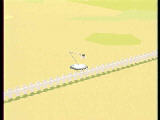
luxo.mpg
Both a series-elastic actuated robot and a simulated model of the
well-known Pixar Luxo lamp was built by Dan Paluska for his Bachelor's
thesis. In this video, the simulated model, under virtual model control,
takes a few jumps.




















